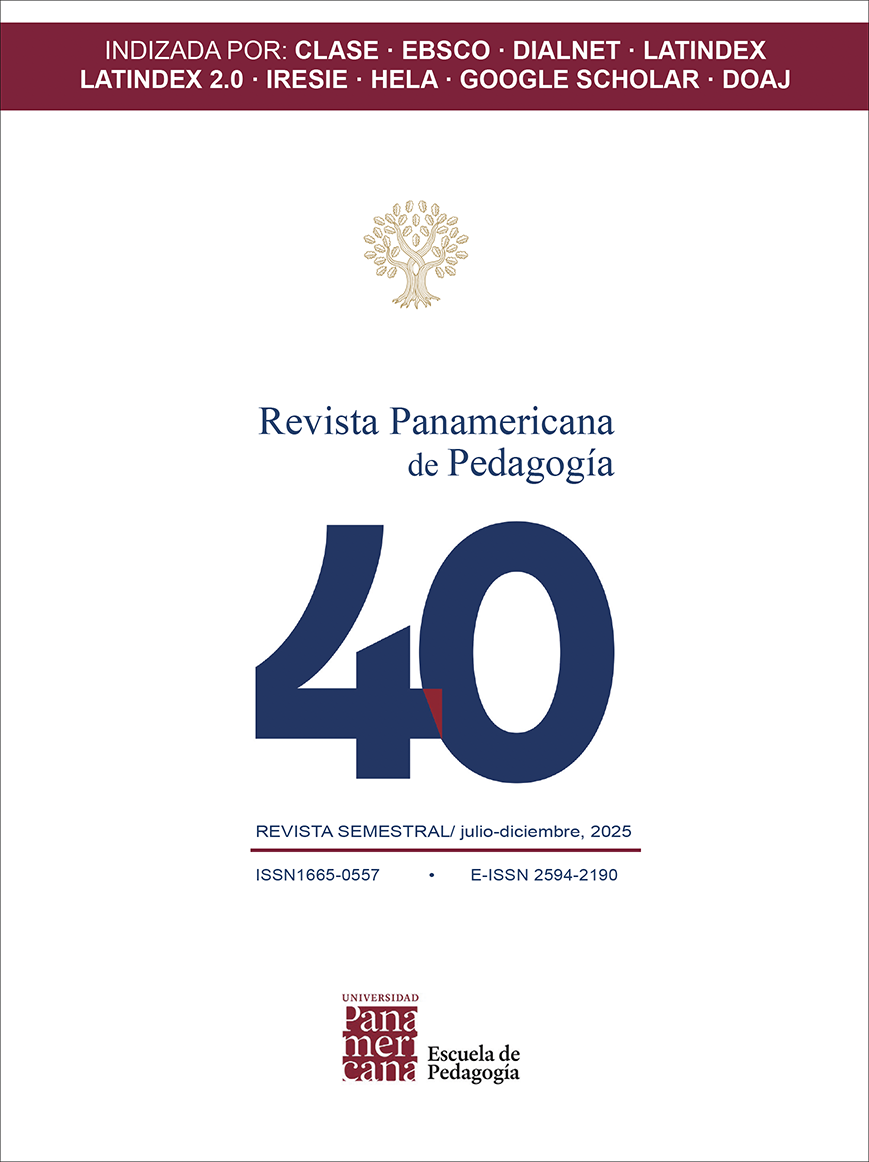Published 2025-06-27
Keywords
- Autoethnography,
- Narrative,
- Constructivism,
- Teaching practice,
- Reflexivity
Copyright (c) 2025 Revista Panamericana de Pedagogía

This work is licensed under a Creative Commons Attribution-NonCommercial-ShareAlike 4.0 International License.
How to Cite
Abstract
The article examines how autoethnography can deepen the understanding of a teacher’s experiences in her personal and professional development. Drawing from a qualitative and constructivist approach, the research employs narratives to analyze and reflect on the teacher’s educational and social interactions, revealing how these experiences have influenced her pedagogical practice. The autoethnographic method enables introspection, fosters a critical perspective, and facilitates comprehension of specific sociocultural contexts. This approach not only enriches educational practice by transforming pedagogical dynamics, but also promotes the teacher’s ongoing professional development. Furthermore, the article underscores the importance of reflexivity, understood as a necessary process for analyzing and reinterpreting lived experiences. Regarding the findings, the research highlights the need for equitable access to continuing education, arguing that such opportunities are essential to improving teaching quality, particularly in regions such as Huila, Colombia. In conclusion, the use of autoethnography in educational research not only offers a valuable tool for teachers’ self-knowledge, but also serves as a vehicle for pedagogical transformation, strengthening educational quality through professional development and adaptation to local contexts.
References
- REFERENCIAS
- Barthes, R. (1977). Introducción al análisis estructural de los relatos. En S. Niccolini (comp.), El análisis estructural (pp. 65-101). Centro Editor de América Latina.
- Barrera Quiroga, D. M. (2023). Narrativa y relato pedagógico. ACTIO Journal of Technology in Design, Film Arts and Visual Communication, 7(2), 1-15. https://revistas.unal.edu.co/index.php/actio/article/view/112382/90667
- Bruner, J. (1991). Actos de significado: más allá de la revolución cognitiva. Alianza.
- Bruner, J. (1995). The autobiographical process. Current sociology, 43(2), 161-177. https://doi.org/10.1177/001139295043002015
- Bruner, J. (1996). Realidad mental y mundos posibles. Los actos de la imaginación que dan sentido a la experiencia. Traducción de Beatriz López. Editorial Gedisa.
- Connelly, F., M. y Clandinin, D., J. (1990). Stories of experience and narrative inquiry. Educational researcher, 19(5), 2-14.
- Contursi, M. E. y Ferro, F. (2000). La narración: usos y teorías. Editorial Norma.
- Denzin, N. K. (1989). Interpretive biography. Sage.
- De Shazer, S. (1999). En un origen, las palabras eran magia. Gedisa.
- Dyson, M. (2007). My story in a profession of stories: autoethnography - an empowering methodology for educators. Australian Journal of Teacher Education, 32(1), 36-48. https://doi.org/10.14221/ajte.2007v32n1.3
- Ellis, C. (1995). Final negotiations: a story of love, loss, and chronic illness. Temple University Press.
- Ellis, C., y Bochner, A. (2000). Autoethnography, personal narrative, reflexivity: researcher as subject. Sage.
- Echeverría, R. (1996). Ontología del Lenguaje. Dolmen.
- Freeman, M. (2004). Data are everywhere: narrative criticism in the literature of experience. En C. Daiute y C. Lightfoot (eds.), Narrative analysis: studying the development of individuals in society (pp. 63-81). Sage.
- Gergen, K. (1996). Realidades y aproximación a la construcción social. Paidós.
- Heikkinen, H. T. (2002). Narrative research, voices of teachers and philosophers. Office.
- Larrosa, J. (2006). Sobre la experiencia. Aloma. Revista de psicologia, ciències de l'educació i de l'esport Blanquerna, 19, 87-112. https://diposit.ub.edu/dspace/bitstream/2445/96984/1/566508.pdf
- MacIntyre, A. (1981). After virtue: an essay in moral theory. University of Notre Dame Press.
- Nawrath, M. H. I. (2010). El método etnográfico: origen y fundamentos de una aproximación multitécnica. Forum Qualitative Sozialforschung/Forum: Qualitative Social Research, 11 (2), Art. 10. https://www.qualitative-research.net/index.php/fqs/article/view/1283/2957
- Ochs, E. (2000). Narrativa. El discurso como estructura y proceso. Estudios sobre el discurso. Gedisa.
- Payne, M. (2000). Terapia narrativa. Paidos.
- Polkinghorne, D. E. (1988). Narrative knowing and the human sciences. State University of New York Press.
- Ricoeur, P. (1999). Historia y narratividad. Paidós.
- Ripamonti, P. (2017). Investigar a través de narrativas: notas epistémico-metodológicas. En M. Alvarado y A. De Oto (eds.), Metodologías en contexto: intervenciones en perspectivas feministas, poscoloniales, latinoamericanas (pp. 83-103). Buenos Aires: CLACSO.
- Ruso, R. C. (2001). El concepto de zona de desarrollo próximo: una interpretación. Revista cubana de psicología, 18(1), 72-76. http://pepsic.bvsalud.org/pdf/rcp/v18n1/09.pdf
- Sánchez, S. C. (2018). La narración, según Bruner, en la formación de la identidad del Yo en el niño. Educación y Futuro Digital, (17), 5-31. https://cesdonbosco.com/documentos/revistaeyfd/EYFD-17.pdf
- Vygotsky, L. (1979). El desarrollo de los procesos psicológicos superiores. Grijalbo.
- White, M. y Epston, D. (1993). Medios narrativos para fines terapéuticos. Paidos.






